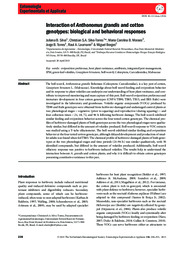Interaction of Anthonomus grandis and cotton genotypes: biological and behavioral responses.
Interaction of Anthonomus grandis and cotton genotypes: biological and behavioral responses.
Author(s): SILVA, J. B.; SILVA-TORRES, C. S. A.; MORAES, M. C. B.; TORRES, J. B.; LAUMANN, R. A.; BORGES, M.
Summary: The boll weevil, Anthonomus grandis Boheman (Coleoptera: Curculionidae), is a key pest of cotton, Gossypium hirsutum L. (Malvaceae). Knowledge about boll weevil feeding and oviposition behavior and its response to plant volatiles can underpin our understanding of host plant resistance, and contribute to improved monitoring and mass capture of this pest. Boll weevil oviposition preference and immature development in four cotton genotypes (CNPA TB90, TB85, TB15, and BRS Rubi) were investigated in the laboratory and greenhouse. Volatile organic compounds (VOCs) produced by TB90 and Rubi genotypes were obtained from herbivore-damaged and undamaged control plants at two phenological stages ? vegetative (prior to squaring) and reproductive (during squaring) ? and four collection times ? 24, 48, 72, and 96 h following herbivore damage. The boll weevil exhibited similar feeding and oviposition behavior across the four tested cotton genotypes. The chemical profiles of herbivore-damaged plants of both genotypes across the two phenological stages were qualitatively similar, but differed in the amount of volatiles produced. Boll weevil response to VOC extracts was studied using a Y-tube olfactometer. The boll weevil exhibited similar feeding and oviposition behavior at the four tested cotton genotypes, although delayed development and production of smaller adults was found when fed TB85. The chemical profile of herbivore-damaged plants of both genotypes at the two phenological stages and time periods (24?96 h) was similar qualitatively, with 30 identified compounds, but differed in the amount of volatiles produced. Additionally, boll weevil olfactory response was positive to herbivory-induced volatiles. The results help to understand the interaction between A. grandis and cotton plants, and why it is difficult to obtain cotton genotypes possessing constitutive resistance to this pest.
Publication year: 2015
Types of publication: Journal article
Observation
Some of Embrapa's publications are published as ePub files. To read them, use or download one of the following free software options to your computer or mobile device. Android: Google Play Books; IOS: iBooks; Windows and Linux: Calibre.
Access other publications
Access the Agricultural Research Database (BDPA) to consult Embrapa's full library collection and records.
Visit Embrapa Bookstore to purchase books and other publications sold by Embrapa.

